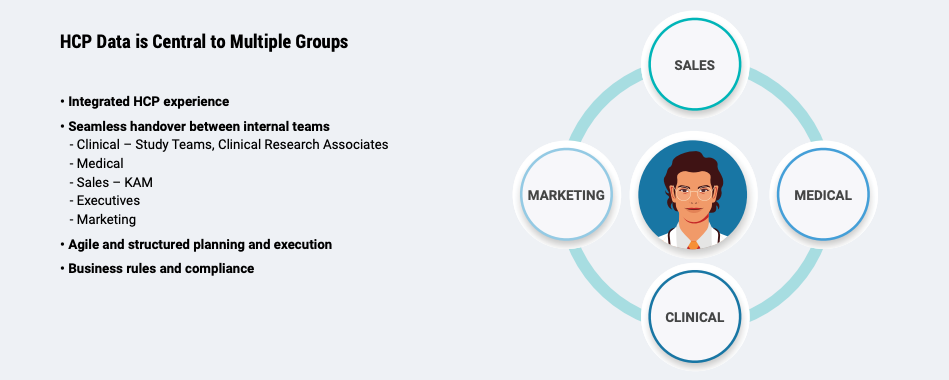eBook
Navigating Customer Data Fragmentation in Biopharma
Biopharmas sit on a goldmine of customer data, buried beneath layers of legacy systems and siloed providers across clinical, medical, and commercial. Meanwhile, the demand for data- driven insights to guide digital and omnichannel efforts is surging. Field teams require more granularity and accuracy to understand healthcare professional (HCP) preferences and deliver high-quality interactions.
Despite advances in HCP engagement software and channels, fragmented data sources reduce field productivity and return on investment in software and analytics initiatives. If not addressed, over time it becomes increasingly difficult to connect an ever-growing number of data sources, negatively impacting data quality and agility.
This eBook covers challenges and strategies for achieving enterprise-wide harmonized data.
Business as usual brings high costs
Poor-quality data costs organizations nearly $13 million annually, in part because repetitive data preparation tasks account for 80% of companies’ time in analytics projects.
What’s the Cost of Poor-Quality, Fragmented Data?
$12.9M
Annual cost of poor data per company.
Source: Gartner, Inc.
80%
Time spent on repetitive tasks in analytics projects.
Source: McKinsey & Company.
10%
Companies with data fragmentation issues under control.
Source: McKinsey & Company.
Imagine building a global report reflecting all field team visits with oncologists last year. However, in your system, every country has a unique definition of oncologist. The task would require repeatedly rebuilding your report because each country’s underlying data structure differs.
Despite the consequences of poor data quality due to fragmented data sources, just 10% of companies say they have the issue under control. If data harmonization is a goal, look for persistent root causes of data fragmentation, such as the following.
Legacy solutions that don’t connect
Legacy systems may look well-organized and connected to newer systems on a chart. Below the surface, they contribute to a spaghetti network of databases, user interfaces, and integrations. Fearing disruption, organizations maintain them, using workarounds and manual corrections that further fragment data.
The repercussions of keeping the status quo are significant and can include:
- Inefficient processes, as different teams use multiple platforms for customer data
- Higher resource utilization, including time spent building integrations
- Ongoing maintenance issues for older systems when upgrades may not be available
- Inaccurate reporting that doesn’t address business needs
- Data change requests (DCRs) and subsequent updates that take days or weeks, delaying HCP interactions
Data is categorized inconsistently
Even when guidelines exist to acquire and maintain customer data globally, harmonization beyond the local level may not occur. Often, each country uses:
- A different model for their HCP data, including basic naming conventions
- Inconsistent HCP specialty and subspecialty lists
- Varying code tables (used to map data fields to CRM fields)
Standardized HCP and healthcare organization (HCO) information and processes promote data consistency and thorough capture of interactions. Sales, medical, and marketing teams across the globe see ‘one customer,’ using a common identifier and representing a cohesive brand in front of customers and prospects.
Connect data for customer-centricity and more
Customers don’t soon forget when biopharma reps communicate with them in a coordinated, relevant, and personalized way. An orchestrated, connected customer experience is achievable when all teams in your organization have a single view of the HCP in their role(s) as investigator, KOL, or prescriber.

Beyond customer-centricity, data unification is the key to scale globally, use AI and analytics initiatives successfully, reduce data costs, and become more agile in any business initiative.
Data harmonization strategies
Following are high-level strategies to consider toward data connectivity:
- Verify the quality of the customer data: Define and document your organization’s needs and make a strategic decision about buying already integrated data or building integrations yourself. Though a best-of-breed approach might comprise more specialized data, it’s more expensive and harder to maintain. Integrated data, while potentially less comprehensive, is more cost-effective. Ideally, choose extendable integrated solutions that allow you to add your own specialized data elements.
- Establish a data core and connect other sources to it: Start by implementing customer master core data using reference data and industry-specific master data management software. Focus on data assets that can be connected in an open, harmonized data architecture.
- Define and establish data governance: Assign data ownership and accountability in each area: clinical, medical, and commercial. Your organization may also decide on an in-house data stewardship approach, handling proprietary data such as HCPs outside of the data subscription that only your company manages.
Harmonized data as the foundation for omnichannel
A harmonized solution — one global data model and one global code table for customer data in all countries — leads to cost savings and more accurate insights for omnichannel initiatives.
Ian Cornish, associate director of data platforms for Astellas, and his team sought to achieve a single source of truth for HCP and HCO data. They viewed the initiative as an essential step in meeting omnichannel aspirations. Working with Veeva, Cornish and his team harmonized their data landscape and now use a global master data solution in 45 countries.
In addition, they replaced eight data/software providers with one.
“With Veeva OpenData Commercial and Veeva Network, we are seeing a rapid uptake in engagement speed. The time it takes from adding a new customer and capturing consent to engaging with that customer using various channels has dropped from nearly five days to less than five hours. It makes a big difference in customer engagement, and ultimately for patients.”

Providing field teams with excellent global customer reference data means they engage the right HCPs, expediting patient treatment. A superior customer experience, scaled globally, begins with tackling data fragmentation.
Read the four foundations of a data-driven biopharma.
